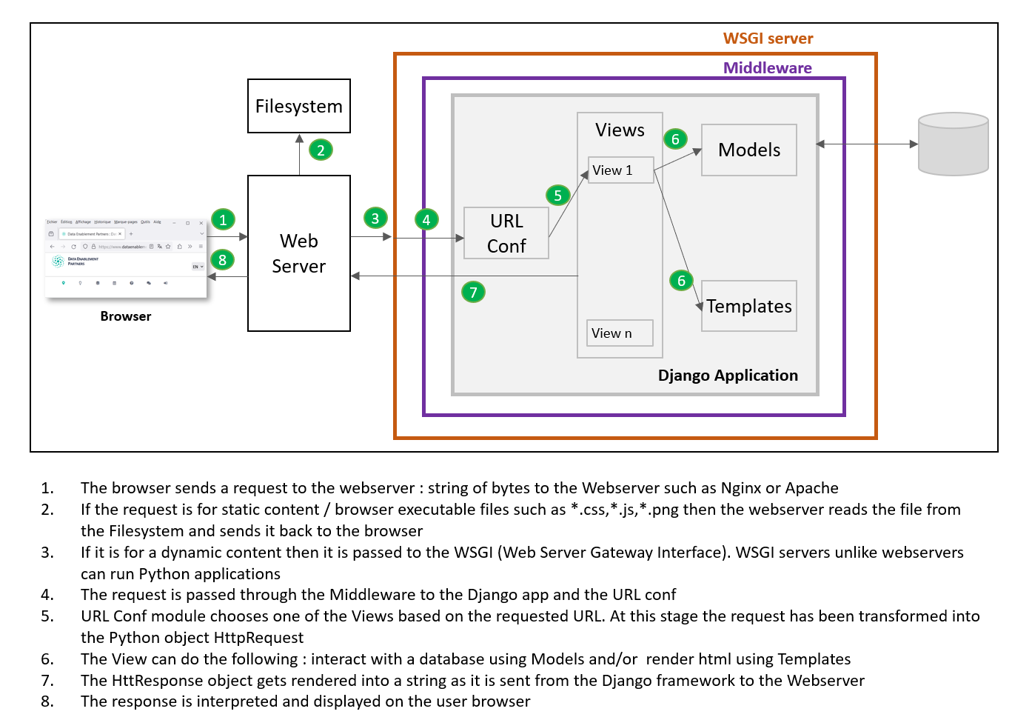Django overview
The following picture describes the mechanism of Django :

Overview of Django configuration
On the Django installation the following directories are created :
myprojectdir
├── manage.py #django utility to manage Django apps
├── myprojectenv #python virtual environment used for Django framework and associated modules
├── myproject #Django installation level directory containing common ressources for all projects
├── static #Django installation level directory containing static *.css, *.js, *.png, ... files for all projects
The myproject directory created automatically at install time contains the following :
myprojectdir
├── manage.py
├── myprojectenv
├── myproject #parent Django project containing common ressources for all projects
├── __init__.py #special Python file that indicates that the parent directory should be treated as a Python package
├── __pycache__ #created on first Python code execution and used in subsequent executions so that the program starts faster
├── asgi.py #asychronous processing equivalent to WSGI used to manage the server side invoking a callable object
├── settings.py #contains all the configuration of the Django installation
├── urls.py #contains all mappings between URLs, that the Django installation serves, and Python views. All URLs of all Django apps need to be declared here
├── wsgi.py #Web Server Gateway Interface to process non static requests such as Python code that need to be executed on server side
When a new Django app is launched using the manage.py command, the django_app directory is created automatically at the same level as the directory myproject and will have the following hierarhy :
myprojectdir
├── manage.py
├── myprojectenv
├── myproject
├── static
├── django_app #directory for each individual Django app
├── __init__.py #special Python file to indicate the directory should be treated as Python package
├── __pycache__ #python cache
├── admin.py #django app admin utility used to customize and configure the Django admin interface for managing models in Django project
├── apps.py #used to configure the application and define application-specific settings and metadata
├── migrations #when changes are done in the database, Django can automatically generate migration files that represent those changes
├── models.py #central component of each Django app, where data models for the application are defined
├── templates #used to store HTML template files that define the structure and layout of the user interface for the web application
├── tests.py #used to write unit tests for the Django application
├── urls.py #used to define URL patterns for the web application
├── views.py #used to define the view functions or classes that handle HTTP requests and generate HTTP responses for the web application
Activate virtual env
To use Django command line, activate the virtual environement
usr1@server:~/myprojectdir$ source myprojectenv/bin/activate
The prompt is changed as follows
(myprojectenv) usr1@server:~/myprojectdir$
Create new Django app
We can now execute Django instructions. To create a new Django app, use the manage.py command.
(myprojectenv) usr1@server:~/myprojectdir$ python3 manage.py startapp demo1
This results in the creation of a directory named demo1 with the following hierarchy.
myprojectdir
├── manage.py
├── myprojectenv
├── myproject
├── static
├── demo1 #directory for each individual Django app
├── __init__.py #special Python file to indicate the directory should be treated as Python package
├── __pycache__ #python cache
├── admin.py #django app admin utility used to customize and configure the Django admin interface for managing models in Django project
├── apps.py #used to configure the application and define application-specific settings and metadata
├── migrations #when changes are done in the database, Django can automatically generate migration files that represent those changes
├── models.py #central component of each Django app, where data models for the application are defined
├── templates #used to store HTML template files that define the structure and layout of the user interface for the web application
├── tests.py #used to write unit tests for the Django application
├── urls.py #used to define URL patterns for the web application
├── views.py #used to define the view functions or classes that handle HTTP requests and generate HTTP responses for the web application